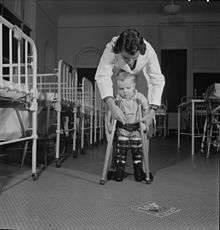Crutch
A crutch is a mobility aid that transfers weight from the legs to the upper body. It is often used for people who cannot use their legs to support their weight, for reasons ranging from short-term injuries to lifelong disabilities.
Types
There are several types of crutches:
- Forearm
- A type of crutch with a cuff at the top to go around the forearm, also known as the Lofstrand crutch. It is the type most commonly used in Europe. A forearm crutch is used by inserting the arm into a cuff and holding the grip. The cuff, typically made of plastic or metal, can be a half-circle or a full circle with a V-type opening in the front allowing the forearm to slip out in case of a fall.
- Underarm or axilla
- It is used by placing the pad against the ribcage beneath the armpit and holding the grip, which is below and parallel to the pad.
- Platform
- These are less common and used by those with poor hand grip due to arthritis, cerebral palsy, or other conditions. The arm rests on a horizontal platform and is strapped in place. The hand rests on a grip which, if properly designed, can be angled appropriately depending on the user's disability.
- Leg Support
- These non-traditional crutches are useful for users with an injury or disability affecting one lower leg only. They function by strapping the affected leg into a support frame that simultaneously holds the lower leg clear of the ground while transferring the load from the ground to the user's knee or thigh. This style of crutch has the advantage of not using the hands or arms while walking. A claimed benefit is that upper thigh atrophy is also reduced because the affected leg remains in use. Unlike other crutch designs these designs are unusable for pelvic, hip or thigh injuries and in some cases for knee injuries also.
Walking sticks or canes serve an identical purpose to crutches, but are held only in the hand and have a limited load bearing capability because of this.
Information on use
Several different gait patterns are possible, and the user chooses which one to use depending on the reason the crutches are needed. For example, a person with a non-weight bearing injury generally performs a "swing-to" gait: lifting the affected leg, the user places both crutches in front of himself, and then swings his uninjured leg to meet the crutches. Other gaits are used when both legs are equally affected by some disability, or when the injured leg is partially weight bearing.[1]
With underarm crutches, sometimes a towel or some kind of soft cover is needed to prevent or reduce armpit injury. A condition known as crutch paralysis, or crutch palsy can arise from pressure on nerves in the armpit, or axilla.[2][3] Specifically, "the brachial plexus in the axilla is often damaged from the pressure of a crutch...In these cases the radial is the nerve most frequently implicated; the ulnar nerve suffers next in frequency."[3]
Alternative devices
The knee scooter and the wheelchair are possible alternatives for patients who cannot use or do not like crutches. These wheeled devices introduce an additional limitation, however, since they cannot negotiate stairs.
Materials
- Wood
- Metal alloys (most often Steel, Aluminium alloys, Titanium alloys)
- Carbon or glass fiber reinforced composites
- Thermoplastic
- Carbon fiber reinforced polymer
See also
References
| Wikimedia Commons has media related to Crutches. |
- ↑ Walk Easy > Interact > Crutch Gait. Retrieved on March 22, 2007.
- ↑ Glanze, W.D., Anderson, K.N., & Anderson, L.E, eds. (1990). Mosby's Medical, Nursing & Allied Health Dictionary (3rd ed.). St. Louis, Missouri: The C.V. Mosby Co. ISBN 0-8016-3227-7. p.324
- 1 2 Warwick, R.; Williams, P.L, eds. (1973). Gray’s Anatomy (35th ed.). London: Longman. p.1046

